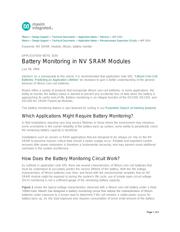下载

Maxim > Design Support > Technical Documents > Application Notes > Memory > APP 3254
Maxim > Design Support > Technical Documents > Application Notes > Microprocessor Supervisor Circuits > APP 3254
Keywords: NV SRAM, module, lithium, battery monitor
APPLICATION NOTE 3254
Battery Monitoring in NV SRAM Modules
Jun 28, 2004
Abstract: As a prerequisite to this article, it is recommended that application note 505, "Lithium Coin-Cell
Batteries: Predicting an Application Lifetime" be reviewed to gain a better understanding of the general
behavior of lithium coin-cell batteries.
Maxim offers a variety of products that incorporate lithium coin-cell batteries. In some applications, the
ability to monitor the battery status is desired to prevent any accidental loss of data when the battery is
approaching its useful end-of-life. Battery monitoring is an integral function of the DS1330, DS1345, and
DS1350 NV SRAM PowerCap Modules.
This battery monitoring feature is also featured for sorting in our Parametric Search of memory products.
Which Applications Might Require Battery Monitoring?
In field installations requiring very long service lifetimes or those where the environment may introduce
some uncertainty in the overall reliability of the battery back-up system, some ability to periodically check
the remaining battery capacity is beneficial.
Installations such as servers or RAID applications that are designed to be 'always-on' rely on the NV
SRAM to preserve mission-critical data should a power outage occur. Reliable and expedient system
recovery after power restoration is therefore a fundamental necessity, and may warrant some additional
overhead in the system architecture.
How Does the Battery Monitoring Circuit Work?
As outlined in application note 505, there are several characteristics of lithium coin-cell batteries that
must be understood to accurately predict the service lifetime of the battery. With the flat voltage
characteristics of lithium batteries over time, and faced with the environmental variables that an NV
SRAM module might be exposed to during the system's life cycle, use of simple open-circuit voltage
(OCV) monitoring is not a sufficient gauge of the remaining battery capacity.
Figure 1 shows the typical voltage characteristics observed with a lithium coin-cell battery under a fixed
100kΩ load. Maxim has designed a battery monitoring circuit that utilizes the characteristics of lithium
batteries under exposure to a known load to determine if the cell remains a viable power source for
battery back-up. As this load exposure also requires consumption of some small amount of the battery
Page 1 of 5







